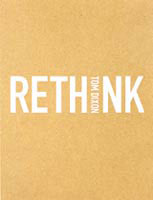Industrial revolution
Tom Dixon, head of design at Habitat, has written a book about alternative interior decor. Matthew Valentine thinks the retailer could learn from the book.

Innovation doesn’t necessarily require actual invention, just a way of seeing existing objects in a different light.
Rethink, a new book by Tom Dixon, takes an innovative and entertaining trawl through the world of cast-offs and the kind of products advertised in industrial catalogues, conjuring up new uses for the wide variety of products found there.
Dixon starts his explorations with a brief, but pointed, criticism of the lack of creativity in modern lighting, furniture and decorative design. As he is head of design at retailer Habitat, all aspiring designers would do well to bear his words in mind for the benefit of their careers.
This lack of originality is what sparks Dixon to seek what he calls “extraordinary examples of natural and anonymous designs”.
The book touches on the ubiquity of certain recycled products: tyres and crates have been recycled so often they don’t even look out of place when used as furniture or beach toys. People throughout the world regularly come up with the same alternative uses for these items.
And while some of the industrial or salvaged furniture in the book has a familiar student chic – there are even traffic cones on display – there is a real attempt to find fun and cheap alternatives to what is on sale in the high street. Patterned floors made of brightly coloured carpet tiles, walls covered with sections of billboard posters, dividing walls made of security shutters and kitchens made of industrial units offer a domestic equivalent to the utility clothing we all wear.
There are ideas for all areas of the home, too. The bright yellow bins used to store grit by the roadside really would make good toy boxes. In fact, many parents have no doubt been tempted to dump their children into one during a long drive.
Indeed, it is a surprise that more of the products featured aren’t advertised, or even directly available, to the public. I know several short people who have tried unsuccessfully for years to buy a Kik Step to help them reach high shelves. By supplying a handy list of addresses at the end of the book, Dixon helps solve their problem.
In a sense, the book acts much like a Habitat catalogue for the financially challenged, showing roomsets and furnishing ideas. Designed by Johnson Banks, the book looks not unlike a trendy furniture catalogue, even using medium-density fibreboard for its cover.
In fact, in its price levels the book seems closer to the spirit of the original so-called Shabitat stores than Habitat itself, which now seems intent on catching its more upmarket rival, Heals. Perhaps some of Dixon’s ideas in Rethink need to be rethought from a book into a shop.
Rethink by Tom Dixon is published by Conran Octopus, price £22.50
-
Post a comment




